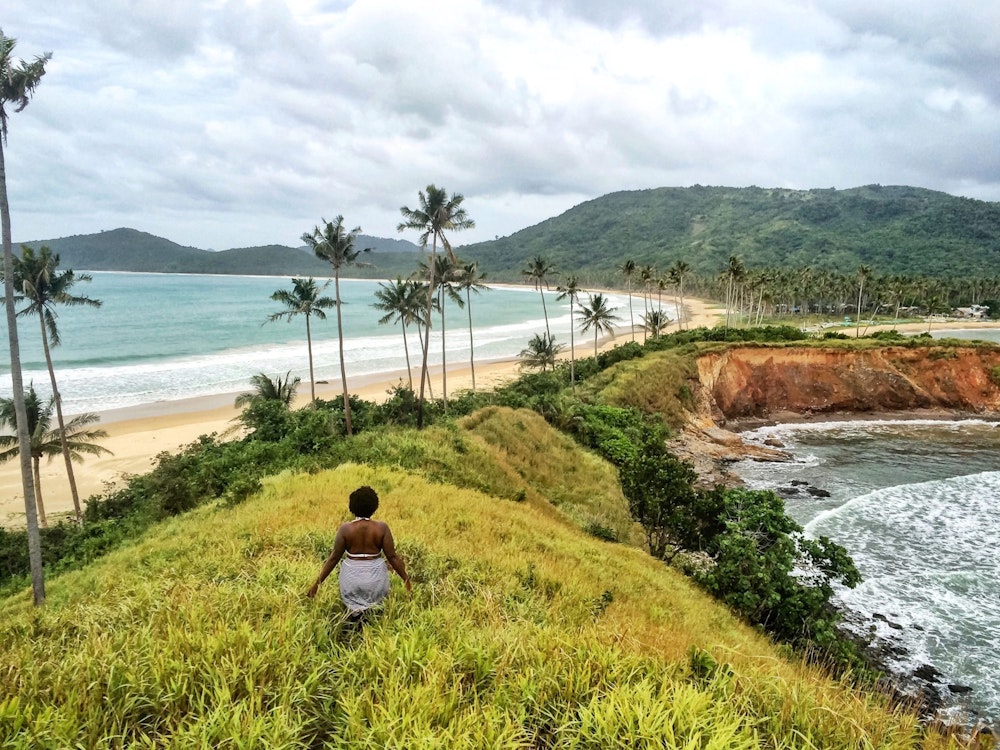
Adam Harrison Levy|Designer/Artist Cooking Series, Essays
November 19, 2013
Designer’s Cookbook: George Lois

George Lois and four of his many, many iconic Esquire covers. Portrait by Timur Civan via Vice.
This is the first in a six-part series from Adam Harrison Levy about designers, artists and cooking.
“No man in the history of the world has eaten the quality of food that I have,” George Lois says in his tough guy Bronx accent. And he might be right. His mother was a magisterial cook; her recipes, written out by hand in Greek, and then copied by scores of relatives and friends, were famous in the insular Greek community of New York in the 1930s where he grew up.
His childhood memories are suffused with food: the handmade sausages that hung from the cords of a drying rack suspended from the kitchen ceiling; the sharp smell of his mother’s vinegary lentil soup that filled their tiny third floor apartment.
Food, for Lois, is inextricably bound to the story of how his father met his mother. “My father was a goat shepherd back in the Old Country. He became a florist when he came here but he couldn’t find a wife. One of his friends, Costas, had an unmarried sister named Vasilike, recently arrived from Greece, who lived with him on his vegetable farm on Staten Island. Haralampos took the ferry from Manhattan to Staten Island to size up the girl. She didn’t have a dowry but Costas told him that she ran the entire house singlehandedly. Costas called her in from the fields. Haralampos looked her over. Costas added that she was an excellent cook and fed all the farmhands. ‘I’ll have her,’ said Haralampos.”
Growing up in the tough Irish Kingsbridge section of the Bronx, Lois was known as the brawling “greaseball” — the Greek kid who could throw a punch. He had his nose broken seven times but he never backed down. Later, at the school for Music and Arts, where he first encountered the work of Picasso, Braque and Gropius, he took those high culture brawlers on the nose as well. He understood that he had the chops to absorb the language of art and transform it into graphic images powerful enough to connect with the everyday street kids he grew up with. And a great advertising man was born.
But if he could bridge the world of art with the world of commerce, could he bridge the Greek immigrant world (and all it represented) with an American life? Could he clear a more difficult hurdle, Xenos, the fear of outsiders and strangers?
When his parents returned to the Old Country for the first time in twenty-seven years, Lois eloped to Baltimore with his Polish-American girlfriend, Rosemary Lewandowki. He called the Lutheran minister who was to marry them and asked if he was prepared to handle the wedding — a Greek Orthodox groom and a Roman Catholic bride. “Give me good material,” he told Lois, and “I’ll do a good job.”
When George told his sister Hariclea that he had married a Polish girl she fainted. When his mother returned from Greece (where she had suffered a stroke on the exact day George had told his sister) she took one look at her only son and announced, “You got married.”
But the real marriage ceremony came when Rosemary, who had never learned to cook from her mother, boldly decided to make George’s mother’s Thanksgiving Day stuffing for the upcoming holiday. This stuffing recipe was held with ultimate and highest regard by the entire family. The story behind it was that Vasilike made Thanksgiving dinner every year for all the men who helped her husband arrange and deliver flowers over the holidays. They would sleep for only two or three hours a night, and the least the Lois family felt that they could do was to feed them.
Vasilike had never previously encountered this American holiday and was appalled when she first learned about the goopy mess that traditionally filled the turkey. So she decided to invent her own recipe. It was a meat stuffing that takes two days to prepare and, by all accounts, it’s extraordinarily delicious.
Rosemary called George’s eldest sister and asked for the recipe. The sister’s response was, “Don’t even try. You’ll only embarrass yourself. It takes something like twenty years to get right.” But Rosemary insisted. “George wants me to make it,” she replied, which was the clincher in male-dominated Greek culture. The sister grudgingly complied. She copied out the recipe out in English and sent it to Rosemary.
“But you don’t cook!” George said, terrified. “But I can read!” was her reply.
The day arrived. Eighteen family members quietly filed into the dinner room. “Rosemary had set a beautiful table,” recalls George, “Momma took her seat. The sliced turkey was passed around. Momma sat there with a smile of skepticism on her face. The stuffing followed. Everyone took some. All eyes were watching Momma. The room was quiet. She picked up her fork. She took a little nibble. She put down the fork. She licked her lips. She picked up her fork and took another nibble. And then she leaned across the table, glared at my sister Hariclea and said, in Greek, “You made this!”
Vasilike Thanasoulis: Thanksgiving Turkey Stuffing (circa 1923)
This recipe was created when Vasilike cooked for the family and fifteen farmhands on her brother’s farm on Staten Island. It was translated into English by her daughter, Hariclea Lois, for Vasilike’s new daughter-in-law, Rosemary Lois in 1951.
(If any substitutions are made for ingredients or procedure the results will not be the responsibility of the Lois family.)
This recipe can serve twelve people or more.
INGREDIENTS:
1 12 lb. fresh turkey with giblets (use the livers only, discard the lung and heart)
1 lb. Bacon
3 lbs. round steak ground
3 eggs
6 slices Arnold stone ground whole wheat bread (moistened in water and squeezed dry)
2 leeks
3 sweet onions (preferably Vidalia)
1 bunch scallions
1/2 bunch celery
1 small bunch Italian parsley
1/2 cup black raisins
1/2 cup pignolia nuts
3 medium size cans Hunt’s tomato sauce
1 lb. whole, skinned and cooked chestnuts in a can or jar Butter, salt and pepper
THE DAY BEFORE THANKSGIVING:
1.) Fry the bacon until quite crisp (do not burn). Drain on paper towels. Cut into 1” pieces.
2.) Roughly chop onions, leeks, scallions, celery and parsley and place in separate bowls.
3.) Slice chestnuts in half.
4.) Roughly chop turkey livers.
5.) Heat a small amount of butter in a large pot and quickly sauteÌ the pignolia nuts until golden, not brown, and add the turkey livers just until rarely cooked. Remove from pot and set aside.
6.) Add to pot: onions, leeks and scallions and brown well, stirring often. (Add a little more butter if necessary. Turn off heat and leave vegetables in pot.)
7.) In a large bowl, with your hands, mix the round steak ground, salt and pepper, eggs and whole wheat bread until well blended. Brown the meat mixture well in a separate pan.
8.) Add browned meat to vegetables in large pot.
9.) Dilute the tomato sauce in 1 and 1/2 cups of water, stir to blend and add to meat mixture.
10.) Add the raw chopped celery and parsley to mixture. Add pignolia nuts and raisins, chestnuts, bacon and giblets. Mix all together very well.
11.) Simmer for 3/4 hour, uncovered, stirring often to keep from burning. 12.) Cool and refrigerate overnight.
THANKSGIVING DAY A.M.: THE TURKEY:
1.) Wash the turkey under cold water several times, inside and out. Remove any pinfeathers observable. Remove the dark red kidneys in the lower back and discard.
2.) Salt and pepper the inside of the turkey and stuff (but don’t pack too full or the bird might split when being roasted).
3.) Tuck the wing tips behind the back of the turkey. Place the crust ends of the loaf of whole wheat bread into the large cavity containing the stuffing to seal the stuffing inside the bird.
4.) Brush melted butter over the whole turkey and salt and pepper well. Place on a rack in a large baking pan and add water to the pan. Make a tent over the turkey with tinfoil, sealing firmly around all sides of the pan. Let the tent rise an inch or so above the turkey breast.
5.) Roast at 325 degrees for 4 hours, removing the tinfoil after 1 1/2 hours and then basting often. If bird looks brown enough at 3 1/2 hours prick the thigh with a fork. If pink juice runs out, continue baking another 1/2 hour or so.
6.) The last half hour, begin simmering the reserved, covered stuffing, stirring often to prevent burning. When turkey is done remove the stuffing from the bird and add it to the simmering stuffing and mix it all well. Carve the turkey and serve a portion of the stuffing beside the slices of turkey.
This article was originally published on Gourmet Live!
Observed
View all
Observed
By Adam Harrison Levy
Related Posts

Business
Courtney L. McCluney, PhD|Essays
Rest as reparations: reimagining how we invest in Black women entrepreneurs

Design Impact
Seher Anand|Essays
Food branding without borders: chai, culture, and the politics of packaging

Graphic Design
Sarah Gephart|Essays
A new alphabet for a shared lived experience

Arts + Culture
Nila Rezaei|Essays
“Dear mother, I made us a seat”: a Mother’s Day tribute to the women of Iran
Recent Posts
Candace Parker & Michael C. Bush on Purpose, Leadership and Meeting the MomentCourtney L. McCluney, PhD|Essays
Rest as reparations: reimagining how we invest in Black women entrepreneurs Food branding without borders: chai, culture, and the politics of packaging Why scaling back on equity is more than risky — it’s economically irresponsibleRelated Posts

Business
Courtney L. McCluney, PhD|Essays
Rest as reparations: reimagining how we invest in Black women entrepreneurs

Design Impact
Seher Anand|Essays
Food branding without borders: chai, culture, and the politics of packaging

Graphic Design
Sarah Gephart|Essays
A new alphabet for a shared lived experience

Arts + Culture
Nila Rezaei|Essays
